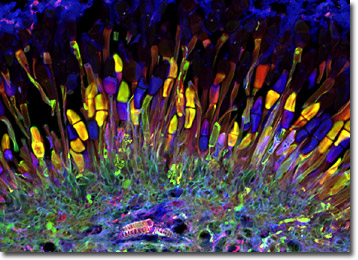 |
 |
 |
|
||||||||||||||||||||||||
 | ||||||||||||||||||||||||
 | ||||||||||||||||||||||||
 | ||||||||||||||||||||||||
Confocal Microscopy Image Gallery
Plant Tissue Autofluorescence Gallery
Hollyhock Rust
The hollyhock is a tall flowering plant belonging to the genus Alcea that is a traditional favorite of English cottagers. The plant has been cultivated in England since at least the Middle Ages, but is native to China.

Hollyhocks are available in annual, biennial, and perennial varieties with blooms in several different colors, including white, yellow, pink, lavender, red, and even black. Multiple blossoms generally form on each plant and extend out individually from the thick, hairy stem on short peduncles. The flowers grow to about 3 inches in diameter and feature five large petals.
Hollyhocks are popular as ornamentals and are best grown in sunny locations, though they can also thrive in partial shade. The most common affliction of the hollyhock is rust, a fungal disease caused by Puccinia malvacearum. This fungus can also infect the mallow weed (Malva rotundifolia), which can worsen outbreaks of hollyhock rust by serving as a fungal reservoir. The disease is usually first noticed when yellow spotting begins to appear on the upper surfaces of hollyhock leaves, but the small orange-brown pustules that initially appear on the underside of the leaves are the most definitive sign of hollyhock rust. The pustules contain numerous tiny teliospores that can be carried by air or rainwater to neighboring plants, where they may also cause disease.
Several strategies are commonly used by gardeners to help stem outbreaks of hollyhock rust. Leaving sufficient space between hollyhocks during planting makes it more difficult for the fungus to infect healthy plants located in the same garden. Also, by removing any mallow in the vicinity of hollyhocks, a key contributor to rust disease can be eliminated. If rust is identified during the growing season, affected parts of the plant should be carefully detached and destroyed. Fungicides play a role in the care of hollyhocks for many gardeners as well, and a number of different varieties are commercially available.
Contributing Authors
Nathan S. Claxton, Shannon H. Neaves, and Michael W. Davidson - National High Magnetic Field Laboratory, 1800 East Paul Dirac Dr., The Florida State University, Tallahassee, Florida, 32310.
